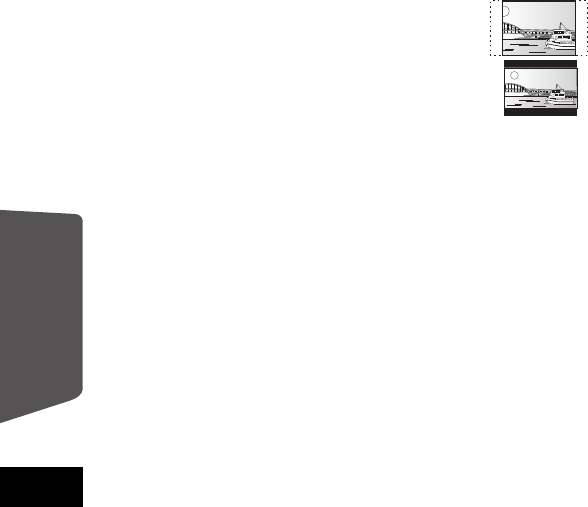
52
RQT9479
Glossary
JPEG (Joint Photographic Experts Group)
This is a system used for compressing/decoding color still pictures. If
you select JPEG as the storage system on digital cameras, etc., the
data will be compressed to 1/10–1/100 of its original size. The benefit
of JPEG is less deterioration in picture quality considering the degree
of compression.
LAN (Local Area Network)
A group of linked devices in a company, school or home.
Indicates the boundaries of a particular network.
Local storage
This storage area is used as a destination for sub contents for playing
BD-Live on BD-Video.
LPCM (Linear PCM)
These are a kind of PCM format.
These are uncompressed digital signals, similar to those found on
CDs.
MPEG2 (Moving Picture Experts Group)
A standard for efficiently compressing and expanding color video.
MPEG2 is a compression standard used for DVD and satellite based
digital broadcasting.
MPEG-4 AVC/H.264
A standard for efficiently compressing and expanding color video.
MPEG-4 AVC/H.264 is an encoding method used for recording of the
high definition videos.
MP3 (MPEG Audio Layer 3)
An audio compression method that compresses audio to
approximately one tenth of its size without any significant loss of audio
quality.
P4HD (Pixel Precision Progressive Processing for HD)
This is a processor which makes use of an exclusive Panasonic
algorithm. Various processing is supported, including a high-level
conversion of the TV scanning format from interlace to progressive
and a high-level conversion of standard resolution (480i or 576i) video
signal to a 1080 High Definition video signal.
Consequently, this unit is able to provide video of optimal resolution to
the connected TV.
Pan&Scan/Letterbox
In general, DVD-Video are produced with the intention that they be
viewed on a widescreen TV (16:9 aspect ratio), so images often don’t
fit regular (4:3 aspect ratio) TVs. Two styles of picture, “Pan & Scan”
and “Letterbox”, deal with this problem.
Pan&Scan:The sides are cut off so the picture fills the
screen.
Letterbox: Black bands appear at the top and bottom
of the picture so the picture itself appears
in an aspect ratio of 16:9.
PCM (Pulse Code Modulation)
This is one format for converting analog audio into digital audio,
enabling you to enjoy digital audio with no hassle.
Picture-in-picture
This is a function of BD-Video that plays the primary video and
secondary video simultaneously. For instance, the function is capable
of playing the original movie as the primary video while playing video
commentary from the film director on a small screen as a secondary
video.
Progressive/Interlace
The video signal standard of NTSC has 480 interlaced (i) scan lines,
whereas progressive (p) scanning uses twice the number of scan
lines, and this is referred to as 480p. Using progressive output, you
can enjoy watching high resolution video.
Router
Distinguishes the IP address assigned to each device, such as the PC,
and relays the flow of data within the network.
Sampling frequency
Sampling is the process of converting the heights of sound wave
(analog signal) samples taken at set periods into digits (digital
encoding). Sampling frequency is the number of samples taken per
second, so larger numbers mean more faithful reproduction of the
original sound.
Subnet mask
Enables efficient network use. A set of numbers which identify which
part of the IP address allocated to every device connected to the
router is the network portion.
VIERA CAST
An information service unique to Panasonic where specific Web sites
can be viewed on this unit by connecting to the Internet without using a
PC.
x.v.Color
TM
x.v.Color
TM
is a name for devices that are compatible with the xvYCC
format, an international standard for expanded color in motion
pictures, and that follow the rules for signal transmission.
You can enjoy vivid colors of wider color ranges for a more realistic
picture when connected to a TV that supports the x.v.Color
TM
with
HDMI cable.
1080i (1125i)
In one high definition image, 1080 (1125) alternating scan lines pass to
create an interlaced image. Because 1080i (1125i) more than doubles
current TV broadcasts of 480i, the detail is much clearer and creates a
more realistic and rich image.
1080p (1125p)
In one high definition image, 1080 (1125) scan lines pass at the same
time to create a progressive image. Since progressive video does not
alternate scan lines like interlace, there is a minimal amount of screen
flicker.
24p
This is a progressive image recorded at a rate of 24 frames per
second.
720p (750p)
In one high definition image, 720 (750) scan lines pass at the same
time to create a progressive image. Since progressive video does not
alternate scan lines like interlace, there is a minimal amount of screen
flicker.
Reference
BTX70PP_eng.book 52 ページ 2009年6月24日 水曜日 午後3時42分


















